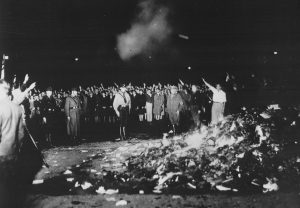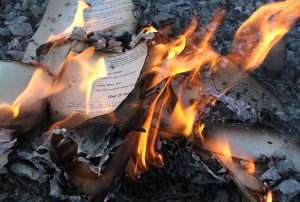 Book burning is the ritual destruction by fire of books or other written materials. This practice is usually carried out in a public place, so as to further destroy any sense of control of one’s own life. The burning of books represents an element of censorship and usually proceeds from a cultural, religious, or political opposition to the materials in question. Sometimes those burning the books think they are “protecting” the people from something they deem to be evil, but more often, the books simply don’t agree with the agenda of the controlling group. Such was the case with the most famous book burning, which took place under the Nazi regime on May 10, 1933. The May 1933 book burning in Nazi Germany was preceded in nineteenth century Germany. In 1817, German student associations (Burschenschaften) chose the 300th anniversary of Luther’s 95 Theses to hold a festival at the Wartburg, a castle in Thuringia where Luther had sought sanctuary after his excommunication. The students were demonstrating for a unified country. Germany was then a patchwork of states. During the protest, the students burned anti-national and reactionary texts and literature which the students viewed as “Un-German” in nature or content. I wonder if they had any idea that the freedom to protest was the very thing they were looking to take away in the future Germany.
Book burning is the ritual destruction by fire of books or other written materials. This practice is usually carried out in a public place, so as to further destroy any sense of control of one’s own life. The burning of books represents an element of censorship and usually proceeds from a cultural, religious, or political opposition to the materials in question. Sometimes those burning the books think they are “protecting” the people from something they deem to be evil, but more often, the books simply don’t agree with the agenda of the controlling group. Such was the case with the most famous book burning, which took place under the Nazi regime on May 10, 1933. The May 1933 book burning in Nazi Germany was preceded in nineteenth century Germany. In 1817, German student associations (Burschenschaften) chose the 300th anniversary of Luther’s 95 Theses to hold a festival at the Wartburg, a castle in Thuringia where Luther had sought sanctuary after his excommunication. The students were demonstrating for a unified country. Germany was then a patchwork of states. During the protest, the students burned anti-national and reactionary texts and literature which the students viewed as “Un-German” in nature or content. I wonder if they had any idea that the freedom to protest was the very thing they were looking to take away in the future Germany.
Then, in 1933, Nazi German authorities, decided to synchronize professional and cultural organizations with Nazi ideology and policy (Gleichschaltung). Nazi Minister for Popular Enlightenment and Propaganda, Joseph Goebbels, spearheaded an effort to bring German arts and culture in line with Nazi goals. The government began to remove cultural organizations of Jewish and other officials who were alleged to be politically suspect or who performed or created art works which Nazi ideologues labeled “degenerate.” Goebbels also had a strong ally in the National Socialist German Students’ Association (Nationalsozialistischer Deutscher Studentenbund), so he used them to bring the literary phase into being. German university students were at the forefront of the early Nazi movement, and in the late 1920s. Many of them filled the ranks of various Nazi formations. The ultra-nationalism and antisemitism of middle-class, secular student organizations had been intense and vocal for decades. After World War I, many students opposed the Weimar Republic (1919–1933) and found in National Socialism a suitable vehicle for their political discontent and hostility.
On April 6, 1933, the Nazi German Student Association’s Main Office for Press and Propaganda proclaimed a nationwide “Action against the Un-German Spirit,” to end in a literary purge or “cleansing” (Säuberung) by fire. Local chapters were to supply the press with releases and commissioned articles, offer blacklists of “un-German” authors, sponsor well-known Nazi figures to speak at public gatherings, and negotiate for radio broadcast time. Then, in a symbolic act of ominous significance, on May 10, 1933, university students burned upwards of 25,000 volumes of “un-German” books, presaging an era of state censorship and control of culture. On the evening of May 10, in most university towns, right-wing students marched in torchlight parades “against the un-German spirit.” The scripted rituals called for high Nazi officials, professors, university rectors, and university student leaders to address the participants and spectators. In Berlin, some 40,000 persons gathered  in the Opernplatz to hear Joseph Goebbels delivered a fiery address: “No to decadence and moral corruption!” He went on to say, “Yes to decency and morality in family and state! I consign to the flames the writings of Heinrich Mann, Ernst Gläser, Erich Kästner.” Among the authors whose books student leaders burned that night were well-known socialists such as Bertolt Brecht and August Bebel; the founder of the concept of communism, Karl Marx; critical “bourgeois” writers like the Austrian playwright Arthur Schnitzler; and “corrupting foreign influences,” among them American author Ernest Hemingway. I don’t agree with some of these writings, but I also don’t agree with their destruction. People can make up their own minds.
in the Opernplatz to hear Joseph Goebbels delivered a fiery address: “No to decadence and moral corruption!” He went on to say, “Yes to decency and morality in family and state! I consign to the flames the writings of Heinrich Mann, Ernst Gläser, Erich Kästner.” Among the authors whose books student leaders burned that night were well-known socialists such as Bertolt Brecht and August Bebel; the founder of the concept of communism, Karl Marx; critical “bourgeois” writers like the Austrian playwright Arthur Schnitzler; and “corrupting foreign influences,” among them American author Ernest Hemingway. I don’t agree with some of these writings, but I also don’t agree with their destruction. People can make up their own minds.


Leave a Reply